Ramneet Kaur
Scalable Bayesian Low-Rank Adaptation of Large Language Models via Stochastic Variational Subspace Inference
Jun 26, 2025Abstract:Despite their widespread use, large language models (LLMs) are known to hallucinate incorrect information and be poorly calibrated. This makes the uncertainty quantification of these models of critical importance, especially in high-stakes domains, such as autonomy and healthcare. Prior work has made Bayesian deep learning-based approaches to this problem more tractable by performing inference over the low-rank adaptation (LoRA) parameters of a fine-tuned model. While effective, these approaches struggle to scale to larger LLMs due to requiring further additional parameters compared to LoRA. In this work we present $\textbf{Scala}$ble $\textbf{B}$ayesian $\textbf{L}$ow-Rank Adaptation via Stochastic Variational Subspace Inference (ScalaBL). We perform Bayesian inference in an $r$-dimensional subspace, for LoRA rank $r$. By repurposing the LoRA parameters as projection matrices, we are able to map samples from this subspace into the full weight space of the LLM. This allows us to learn all the parameters of our approach using stochastic variational inference. Despite the low dimensionality of our subspace, we are able to achieve competitive performance with state-of-the-art approaches while only requiring ${\sim}1000$ additional parameters. Furthermore, it allows us to scale up to the largest Bayesian LLM to date, with four times as a many base parameters as prior work.
Calibrating Uncertainty Quantification of Multi-Modal LLMs using Grounding
Apr 30, 2025Abstract:We introduce a novel approach for calibrating uncertainty quantification (UQ) tailored for multi-modal large language models (LLMs). Existing state-of-the-art UQ methods rely on consistency among multiple responses generated by the LLM on an input query under diverse settings. However, these approaches often report higher confidence in scenarios where the LLM is consistently incorrect. This leads to a poorly calibrated confidence with respect to accuracy. To address this, we leverage cross-modal consistency in addition to self-consistency to improve the calibration of the multi-modal models. Specifically, we ground the textual responses to the visual inputs. The confidence from the grounding model is used to calibrate the overall confidence. Given that using a grounding model adds its own uncertainty in the pipeline, we apply temperature scaling - a widely accepted parametric calibration technique - to calibrate the grounding model's confidence in the accuracy of generated responses. We evaluate the proposed approach across multiple multi-modal tasks, such as medical question answering (Slake) and visual question answering (VQAv2), considering multi-modal models such as LLaVA-Med and LLaVA. The experiments demonstrate that the proposed framework achieves significantly improved calibration on both tasks.
Safety Monitoring for Learning-Enabled Cyber-Physical Systems in Out-of-Distribution Scenarios
Apr 18, 2025Abstract:The safety of learning-enabled cyber-physical systems is compromised by the well-known vulnerabilities of deep neural networks to out-of-distribution (OOD) inputs. Existing literature has sought to monitor the safety of such systems by detecting OOD data. However, such approaches have limited utility, as the presence of an OOD input does not necessarily imply the violation of a desired safety property. We instead propose to directly monitor safety in a manner that is itself robust to OOD data. To this end, we predict violations of signal temporal logic safety specifications based on predicted future trajectories. Our safety monitor additionally uses a novel combination of adaptive conformal prediction and incremental learning. The former obtains probabilistic prediction guarantees even on OOD data, and the latter prevents overly conservative predictions. We evaluate the efficacy of the proposed approach in two case studies on safety monitoring: 1) predicting collisions of an F1Tenth car with static obstacles, and 2) predicting collisions of a race car with multiple dynamic obstacles. We find that adaptive conformal prediction obtains theoretical guarantees where other uncertainty quantification methods fail to do so. Additionally, combining adaptive conformal prediction and incremental learning for safety monitoring achieves high recall and timeliness while reducing loss in precision. We achieve these results even in OOD settings and outperform alternative methods.
Addressing Uncertainty in LLMs to Enhance Reliability in Generative AI
Nov 04, 2024Abstract:In this paper, we present a dynamic semantic clustering approach inspired by the Chinese Restaurant Process, aimed at addressing uncertainty in the inference of Large Language Models (LLMs). We quantify uncertainty of an LLM on a given query by calculating entropy of the generated semantic clusters. Further, we propose leveraging the (negative) likelihood of these clusters as the (non)conformity score within Conformal Prediction framework, allowing the model to predict a set of responses instead of a single output, thereby accounting for uncertainty in its predictions. We demonstrate the effectiveness of our uncertainty quantification (UQ) technique on two well known question answering benchmarks, COQA and TriviaQA, utilizing two LLMs, Llama2 and Mistral. Our approach achieves SOTA performance in UQ, as assessed by metrics such as AUROC, AUARC, and AURAC. The proposed conformal predictor is also shown to produce smaller prediction sets while maintaining the same probabilistic guarantee of including the correct response, in comparison to existing SOTA conformal prediction baseline.
Automating Weak Label Generation for Data Programming with Clinicians in the Loop
Jul 10, 2024Abstract:Large Deep Neural Networks (DNNs) are often data hungry and need high-quality labeled data in copious amounts for learning to converge. This is a challenge in the field of medicine since high quality labeled data is often scarce. Data programming has been the ray of hope in this regard, since it allows us to label unlabeled data using multiple weak labeling functions. Such functions are often supplied by a domain expert. Data-programming can combine multiple weak labeling functions and suggest labels better than simple majority voting over the different functions. However, it is not straightforward to express such weak labeling functions, especially in high-dimensional settings such as images and time-series data. What we propose in this paper is a way to bypass this issue, using distance functions. In high-dimensional spaces, it is easier to find meaningful distance metrics which can generalize across different labeling tasks. We propose an algorithm that queries an expert for labels of a few representative samples of the dataset. These samples are carefully chosen by the algorithm to capture the distribution of the dataset. The labels assigned by the expert on the representative subset induce a labeling on the full dataset, thereby generating weak labels to be used in the data programming pipeline. In our medical time series case study, labeling a subset of 50 to 130 out of 3,265 samples showed 17-28% improvement in accuracy and 13-28% improvement in F1 over the baseline using clinician-defined labeling functions. In our medical image case study, labeling a subset of about 50 to 120 images from 6,293 unlabeled medical images using our approach showed significant improvement over the baseline method, Snuba, with an increase of approximately 5-15% in accuracy and 12-19% in F1 score.
Detection of Adversarial Physical Attacks in Time-Series Image Data
Apr 27, 2023



Abstract:Deep neural networks (DNN) have become a common sensing modality in autonomous systems as they allow for semantically perceiving the ambient environment given input images. Nevertheless, DNN models have proven to be vulnerable to adversarial digital and physical attacks. To mitigate this issue, several detection frameworks have been proposed to detect whether a single input image has been manipulated by adversarial digital noise or not. In our prior work, we proposed a real-time detector, called VisionGuard (VG), for adversarial physical attacks against single input images to DNN models. Building upon that work, we propose VisionGuard* (VG), which couples VG with majority-vote methods, to detect adversarial physical attacks in time-series image data, e.g., videos. This is motivated by autonomous systems applications where images are collected over time using onboard sensors for decision-making purposes. We emphasize that majority-vote mechanisms are quite common in autonomous system applications (among many other applications), as e.g., in autonomous driving stacks for object detection. In this paper, we investigate, both theoretically and experimentally, how this widely used mechanism can be leveraged to enhance the performance of adversarial detectors. We have evaluated VG* on videos of both clean and physically attacked traffic signs generated by a state-of-the-art robust physical attack. We provide extensive comparative experiments against detectors that have been designed originally for out-of-distribution data and digitally attacked images.
Using Semantic Information for Defining and Detecting OOD Inputs
Feb 21, 2023Abstract:As machine learning models continue to achieve impressive performance across different tasks, the importance of effective anomaly detection for such models has increased as well. It is common knowledge that even well-trained models lose their ability to function effectively on out-of-distribution inputs. Thus, out-of-distribution (OOD) detection has received some attention recently. In the vast majority of cases, it uses the distribution estimated by the training dataset for OOD detection. We demonstrate that the current detectors inherit the biases in the training dataset, unfortunately. This is a serious impediment, and can potentially restrict the utility of the trained model. This can render the current OOD detectors impermeable to inputs lying outside the training distribution but with the same semantic information (e.g. training class labels). To remedy this situation, we begin by defining what should ideally be treated as an OOD, by connecting inputs with their semantic information content. We perform OOD detection on semantic information extracted from the training data of MNIST and COCO datasets and show that it not only reduces false alarms but also significantly improves the detection of OOD inputs with spurious features from the training data.
CODiT: Conformal Out-of-Distribution Detection in Time-Series Data
Jul 24, 2022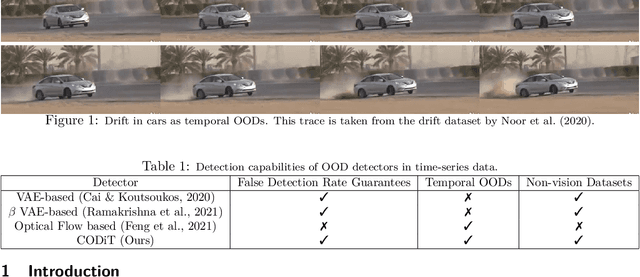


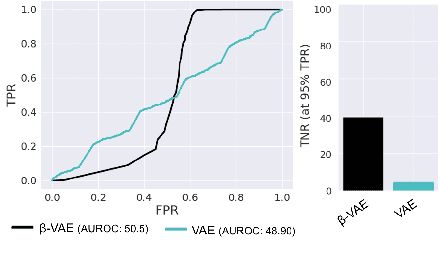
Abstract:Machine learning models are prone to making incorrect predictions on inputs that are far from the training distribution. This hinders their deployment in safety-critical applications such as autonomous vehicles and healthcare. The detection of a shift from the training distribution of individual datapoints has gained attention. A number of techniques have been proposed for such out-of-distribution (OOD) detection. But in many applications, the inputs to a machine learning model form a temporal sequence. Existing techniques for OOD detection in time-series data either do not exploit temporal relationships in the sequence or do not provide any guarantees on detection. We propose using deviation from the in-distribution temporal equivariance as the non-conformity measure in conformal anomaly detection framework for OOD detection in time-series data.Computing independent predictions from multiple conformal detectors based on the proposed measure and combining these predictions by Fisher's method leads to the proposed detector CODiT with guarantees on false detection in time-series data. We illustrate the efficacy of CODiT by achieving state-of-the-art results on computer vision datasets in autonomous driving. We also show that CODiT can be used for OOD detection in non-vision datasets by performing experiments on the physiological GAIT sensory dataset. Code, data, and trained models are available at https://github.com/kaustubhsridhar/time-series-OOD.
Towards Alternative Techniques for Improving Adversarial Robustness: Analysis of Adversarial Training at a Spectrum of Perturbations
Jun 13, 2022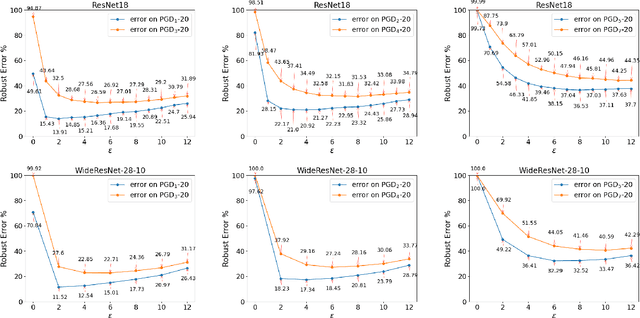
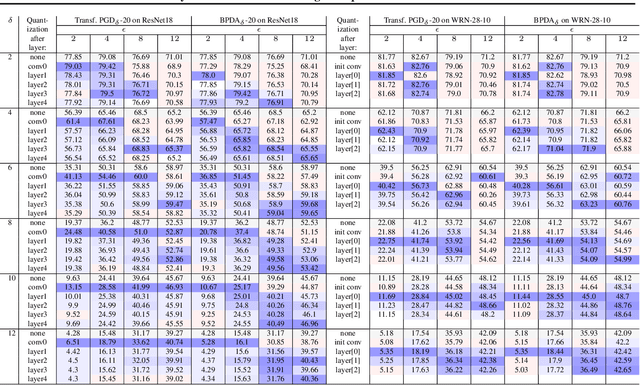
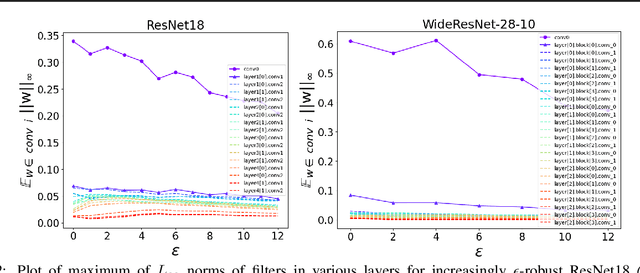
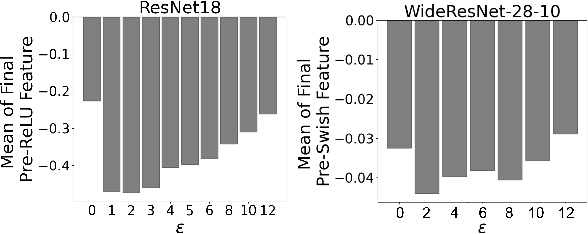
Abstract:Adversarial training (AT) and its variants have spearheaded progress in improving neural network robustness to adversarial perturbations and common corruptions in the last few years. Algorithm design of AT and its variants are focused on training models at a specified perturbation strength $\epsilon$ and only using the feedback from the performance of that $\epsilon$-robust model to improve the algorithm. In this work, we focus on models, trained on a spectrum of $\epsilon$ values. We analyze three perspectives: model performance, intermediate feature precision and convolution filter sensitivity. In each, we identify alternative improvements to AT that otherwise wouldn't have been apparent at a single $\epsilon$. Specifically, we find that for a PGD attack at some strength $\delta$, there is an AT model at some slightly larger strength $\epsilon$, but no greater, that generalizes best to it. Hence, we propose overdesigning for robustness where we suggest training models at an $\epsilon$ just above $\delta$. Second, we observe (across various $\epsilon$ values) that robustness is highly sensitive to the precision of intermediate features and particularly those after the first and second layer. Thus, we propose adding a simple quantization to defenses that improves accuracy on seen and unseen adaptive attacks. Third, we analyze convolution filters of each layer of models at increasing $\epsilon$ and notice that those of the first and second layer may be solely responsible for amplifying input perturbations. We present our findings and demonstrate our techniques through experiments with ResNet and WideResNet models on the CIFAR-10 and CIFAR-10-C datasets.
iDECODe: In-distribution Equivariance for Conformal Out-of-distribution Detection
Jan 07, 2022



Abstract:Machine learning methods such as deep neural networks (DNNs), despite their success across different domains, are known to often generate incorrect predictions with high confidence on inputs outside their training distribution. The deployment of DNNs in safety-critical domains requires detection of out-of-distribution (OOD) data so that DNNs can abstain from making predictions on those. A number of methods have been recently developed for OOD detection, but there is still room for improvement. We propose the new method iDECODe, leveraging in-distribution equivariance for conformal OOD detection. It relies on a novel base non-conformity measure and a new aggregation method, used in the inductive conformal anomaly detection framework, thereby guaranteeing a bounded false detection rate. We demonstrate the efficacy of iDECODe by experiments on image and audio datasets, obtaining state-of-the-art results. We also show that iDECODe can detect adversarial examples.
 Add to Chrome
Add to Chrome Add to Firefox
Add to Firefox Add to Edge
Add to Edge